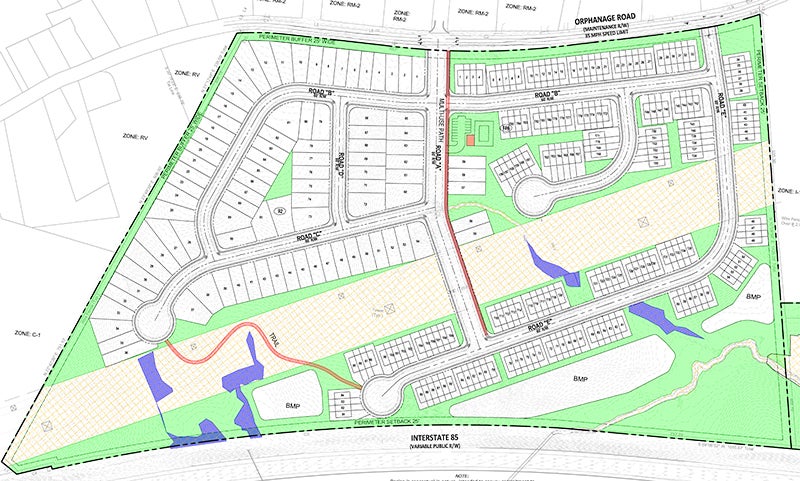Kannapolis council approves 278-unit housing development after three-hour hearing
Published 1:15 am Tuesday, November 26, 2019

- Site plan for Childers Park at Buffalo Creek.
KANNAPOLIS – A contentious, three-hour rezoning hearing on a residential development Monday night is expected to result in the creation of an endowment to sustain the Church of God Children’s Home in perpetuity.
The rezoning of a 72-acre tract at the Concord-Kannapolis city limits was passed on a 5-1 vote, with Councilwoman Dianne Berry the lone “no” vote and Roger Haas absent. The site was previously zoned light industrial. It was rezoned Monday to a designation called planned unit development with a conditional zoning district.
In Kannapolis’ ordinances, a planned unit development designation is defined as a mix of “residential and nonresidential land uses of a quality that could not be achieved under conventional zoning.”
The Church of God Children’s Home plans to sell the property to Charlotte-based CHLC Investments, which would build 92 single-family houses and 186 townhomes in a development called Childers Park at Buffalo Creek. Developers say the average sales price is projected to be about $250,000 and that the development would include a pool, community center, walking trails, sidewalks and significant green space.
Hundreds of people attended Monday’s meeting, with supporters wearing white and green “vote to rezone T-shirts.” Proponents spoke about benefits for the orphanage. Developers focused, in part, on more intensive, industrial uses that were possible as well as their hope to build a community-oriented neighborhood. Opponents spoke about traffic safety and the character of the proposed development.
People affiliated with the orphanage described the organization’s history and future when speaking in favor. Charles Cannon — son of Cannon Mills founder James William Cannon and, later, president of the company — was instrumental in founding the orphanage. Charles Cannon hoped to give children a “forever home,” and the sale of the 72 acres would create an endowment that would keep the orphanage in operation forever, said Beth Minehart.
The rezoning, Minehart said, also would be a win for the city because of new tax revenue.
Developer Ray Holt estimated the property, once complete, would bring $900,000 in new tax revenue for the city and Cabarrus County.
Brad McDaniel, who identified himself as the real estate broker for the project, said the orphanage and developers had changed plans from hundreds of apartments to something that’s a good fit and comes with a good sales price for the orphanage.
Initial plans had included 252 apartments and townhomes, Holt said. Changes were prompted by community feedback, he said.
McDaniel said the average sales price of nearby houses is $172,000. So, he reasoned, the new development would increase nearby property values.
The Rev. Greg Sloop, pastor of Kannapolis Church of God, called the development “a great opportunity to help others in need.”
Opponents clarified they weren’t opposed to the orphanage making a profit. Opposition was primarily focused on increased traffic on a stretch of “a quiet country lane” that, opponents said, is already dangerous. More than one person said the number of residential units would be 7.8 per acre after subtracting land that couldn’t be developed because it is wetlands or has Duke Energy easements for power lines. Opponents questioned daily traffic measurements from the N.C. Department of Transportion, too.
The proposal would be a high-density development next to a neighborhood of single-family homes, said Chris Hamby, who lives on nearby Barfield Street.
“The church wants to make you feel like it’s all about the kids,” Hamby said. “What we are coming down to is the property owners cannot sell land the way it’s currently zoned.”
Once the orphanage receives its money, Hamby said, residents who live nearby would be left to deal with any safety hazards created.
Terry Arnold said she has lived in a farmhouse near the proposed development for almost 30 years. Arnold accused developers of being vague and providing inconsistent numbers as they’ve moved through the approval process. And Arnold asked whether children should actually be playing under power lines and in floodplains that developers had designated green space.
Opponents also presented a petition to the Kannapolis City Council with nearly 500 signatures.
While Cabarrus County board member Barry Shoemaker said he wasn’t speaking for or against the rezoning, but he raised a number of concerns about how the development would affect schools.
Shoemaker estimated the development would add 130 students over five years to nearby schools in the Cabarrus County system and require “at least three or four busloads of children going in and out each day.” If the development’s layout wasn’t engineered properly, Shoemaker said, students could be in danger.
Following the public hearing, members of the City Council asked developers if they could alter the proposed layout — removing townhomes or keeping them away from the view of existing single-family homes. That would require negotiating a price reduction with the orphanage, developers said. They declined to alter the development’s layout Monday night.
After some discussion by the City Council, member Tom Kincaid made a motion to approve the rezoning. It was seconded by Councilman Van Rowell.
Following approval and as the council took a recess, a man in a blue sweatshirt walked up to the dais and yelled, “The next person who dies on that road, you have blood on your hands.” He turned to people associated with the orphanage and repeated the statement before storming out of the council chambers.
Contact editor Josh Bergeron at 704-797-4248.

